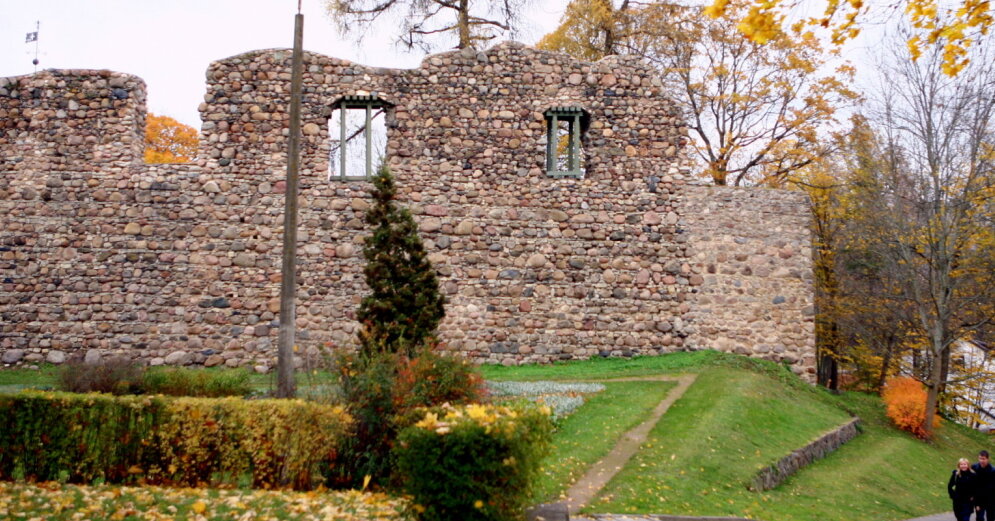Valmiera The castle was built in the 14th century by Latgalians living in the Valmiera area under the guidance of German masters, according to archeological finds, Zane Bulmeistare, Deputy Head of the Brand Management and Public Relations Department of Valmiera City Municipality, informed.
–
Content will continue after the ad
Advertising
–
As reported, during the establishment of the Valmiera Cultural Environment Center, archeological excavations are taking place in the castle territory.
“Currently we are standing at the beginning of Valmiera Castle, at the beginning of Valmiera in the 14th century. Here we see a burning zone. Most likely, burned branches, the construction of the castle starting with deforestation. the local workforce – Latgalians living in the Valmiera area – led by German masters, as this was the castle of the Livonian branch of the German Order, “said the archaeologist, University of Latvia History of Latvia researcher of the institute Rūdolfs Brūzis.
Brūzis provides archaeological supervision during the construction of the Valmiera Cultural Environment Center, which began when the builders worked together with a team of archaeologists.
The historian explained that by finding a shield bracelet and wreath pendants typical of Latgalians, which probably got stuck and tore while working somewhere, archaeologists had obtained confirmation from the legend that both men and women worked in the construction of the castle.
In the northern part of the castle, where there was a courtyard, archeological excavations were carried out in 2018 under the direction of the archaeologist of the Latvian Institute of History Tatjana Berga. At present, archaeologists have the opportunity to “dive deeper into the depths of centuries by 70 centimeters,” said Bulmeistare. In addition, it is very valuable that a relatively large area is available for research, which allows us to see the connections between different centuries, she added.
“Researchers of construction history date the walls to the 14th century. They were built by locals under the guidance of German masters. The legend says that during the work women were allowed to breastfeed their sons twice and daughters once a day. to keep them together while working, “said Bruzis.
We can read about the bells at the wreaths in legends. Most likely, their task was to protect them from evil spirits. The sound creates a wave, such as an aura that protects, added Indra Vīlistere, Head of the Collections Department of the Valmiera Museum.
Bruce emphasized that each find is very valuable because it contains a story. “These are fragments of a clay pot. It was also cooked here, eaten. We see a wavy ornament along the edge. Analyzing the burn inside, let’s find out what kind of food was prepared in this pot. And this is a bullet or hook shot. “Tear it off, otherwise there is a risk that the bullet will get stuck in the barrel and a powder explosion will injure the shooter himself,” the historian commented on the findings.
Knife – probably from the 17th century, oven pot piece – 16th century, 1814 double cup, for which you could buy a large bag of flour, so the loss of the coin was most likely a great loss, elixir and ointment dishes from the Old Pharmacy, oyster , because in the Middle Ages no serious feast took place without them, the discoveries were marked by a historian.
Research is still ongoing. After that, anyone interested will be able to see the finds in the Valmiera Museum. Willist said that the find alone is not enough, then it should be seriously analyzed and restored if possible.
“In Valmiera, a lot was burned during the wars, but many miracles are still underground. Each find is special both as a whole and in helping to see the big picture. For example, they tell about the time when Vidzeme Latgalians were here with the Germans are rare, so every find makes you breathe, “said Willistere.
As reported, the construction of the Valmiera Castle Cultural Environment Center is being implemented by attracting funding from the European Union project “Preserve, protect and develop significant cultural and natural heritage, as well as develop related services” from two projects – the 1st stage project “Culture, history, architecture Gauja and Time Circles “and the 3rd round project” Development of Valmiera Historical Center “.
The European Regional Development Fund (ERDF) funding of 1,032,900 euros, the state budget grant to the local government of 38,823 euros and the local government co-financing of 155,294 euros are planned for the implementation of the project “Culture, History, Architecture in the Gauja and Time Circles”. For the implementation of the project “Development of Valmiera Historical Center” ERDF financing is planned 2 000 000,00 euros, state budget grant to the local government 70 588, euro and local government financing 1 409 108 euros.
–


